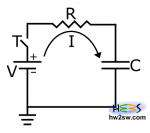One classical example to take confidence in electronic circuits is related to charging/discharging capacitors (symbol: C).
These components are able to catch electrical charges and to keep them for a long time; theoretically for an infinite one, but this is impossible, first of all because of Joule effect (heat dissipation to the ambient with slow progressive energy loosing).

How can they catch?
Power supply is necessary to give the circuit the necessary power supply, without which nothing can work.
Usually a resistor (symbol: R) is inserted is series with capacitor, to regulate time of operation: in facts resistors offer opposition to current flowing, so that charges go to capacitors (or anything else) in a major time than without them.
A little of mathematics:
means that a capacitor can accumulate Q charges (positive on one side and negative on the other) if powered with voltage V.
Farad is the measure unit of electrical capacity, and is given by ratio between Coulomb and Volt.
has dimension of seconds, and indicates time for the capacitor to be charged/discharged by
of its maximum.
Generally a capacitor is considered charged at 99%, in nearly seconds.